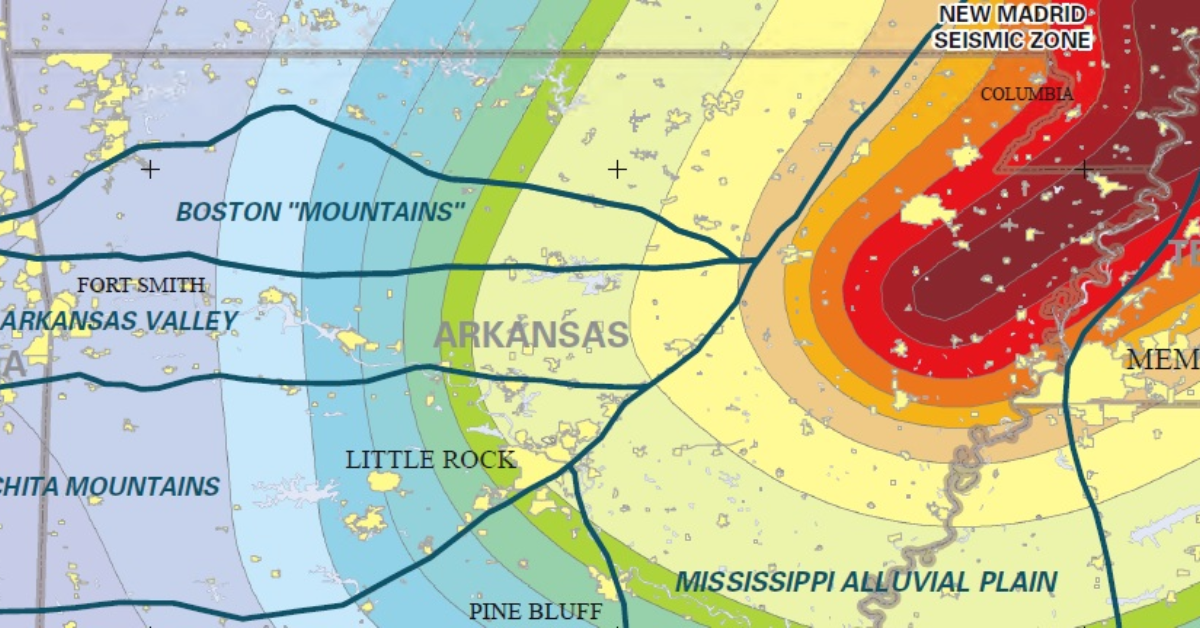The threat of a significant earthquake looms in Northeast Arkansas, particularly from the New Madrid Seismic Zone, which stretches across the region. Although Arkansas has experienced relatively few noticeable quakes in recent years, experts stress the importance of being prepared, as the possibility of a major quake remains high.
The Risk of Earthquakes in Arkansas
Arkansas is not typically associated with earthquakes, especially compared to states like California, which are known for their seismic activity. However, the New Madrid Seismic Zone, which runs through Arkansas, remains one of the most dangerous fault systems in the country.
This fault zone is responsible for several destructive quakes, including those that struck in 1811 and 1812, and experts say that the risk of future earthquakes in the region is far from over. In fact, the U.S. Geological Society predicts a 25% to 40% chance of a magnitude 6.0 or higher earthquake in the area over the next 50 years.
Scott Ausbrooks, an Arkansas state geologist, emphasizes the certainty of a future quake. “It’s not if, but when,” he said. Despite the long gap between large quakes, the threat remains very real.
What Are the Potential Consequences?
A magnitude 6.0 earthquake could cause widespread damage in the region. According to Hilda Booth, Earthquake Program Manager for the Arkansas Department of Public Safety, the aftermath of such a quake could include:
- The collapse of older buildings
- Disruption to roadways
- Power outages across large areas
- Damage to infrastructure like cell phone towers
This kind of damage could severely impact both urban and rural communities, which is why experts continuously emphasize the importance of preparing for earthquakes, even though they are unpredictable.
Why Are We So Vulnerable?
Unlike tornadoes, which are frequent and can be predicted to some extent, earthquakes offer no warning signs. Many people in Arkansas remain complacent due to the infrequency of significant seismic activity. On average, the New Madrid Seismic Zone experiences 250 to 300 earthquakes annually, but most of these are so small (between 1.0 and 2.0 in magnitude) that they go unnoticed.
However, the occasional larger quake serves as a stark reminder that the region is at risk. In fact, just last year, a series of earthquakes rattled parts of Missouri, Tennessee, and Arkansas, including one that was felt in the region with a magnitude of 3.0.
Historical Context: The 1811-1812 Earthquakes
The New Madrid Seismic Zone is best known for the devastating earthquakes that occurred in 1811 and 1812. These quakes were so powerful that they were felt as far away as the East Coast. The first quake, which struck on December 16, 1811, was estimated to be a magnitude of 7.7, with several strong aftershocks following. Geologists have found evidence of these earthquakes’ impact in the form of liquefaction—an event in which the ground becomes so compressed that it erupts in bursts of sand and liquid.
Experts believe that these early quakes were triggered by tectonic shifts in the Earth’s crust. Unlike the West Coast, where earthquakes are caused by the movement of tectonic plates against each other, the New Madrid fault zone’s quakes are believed to be caused by the compression of plates in the Earth’s midsection. This unique geologic setting makes predicting earthquakes in the region even more challenging.
Are We Prepared for the Next Big One?
As experts point out, preparedness is key. While the past few years have seen relatively few major earthquakes in the region, it only takes one large tremor to cause significant damage. The Arkansas Department of Emergency Management and other agencies are continually spreading awareness about the risks and providing guidance on how to prepare.
Some of the basic safety recommendations include:
- Securing heavy furniture like bookcases and hot water heaters to prevent them from falling during a quake.
- Creating emergency kits with essential supplies like water, food, and medical supplies.
- Ensuring that buildings, especially older structures, are fortified to withstand the tremors.
Local authorities also regularly assess critical infrastructure, such as roads and emergency shelters, to make sure they can support rescue efforts in the event of a disaster.
What Can You Do to Be Prepared?
Residents in northeast Arkansas should take proactive steps to prepare for a potential earthquake. Awareness is the first step, followed by practical actions like:
- Developing an emergency plan with family members.
- Participating in earthquake safety drills in schools and workplaces.
- Keeping emergency supplies readily available.
As the experts remind us, “It’s not a matter of if, but when.” The New Madrid Seismic Zone continues to pose a significant risk, and residents in the affected regions must remain vigilant and ready.
Disclaimer: This article has been meticulously fact-checked by our team to ensure accuracy and uphold transparency. We strive to deliver trustworthy and dependable content to our readers.

